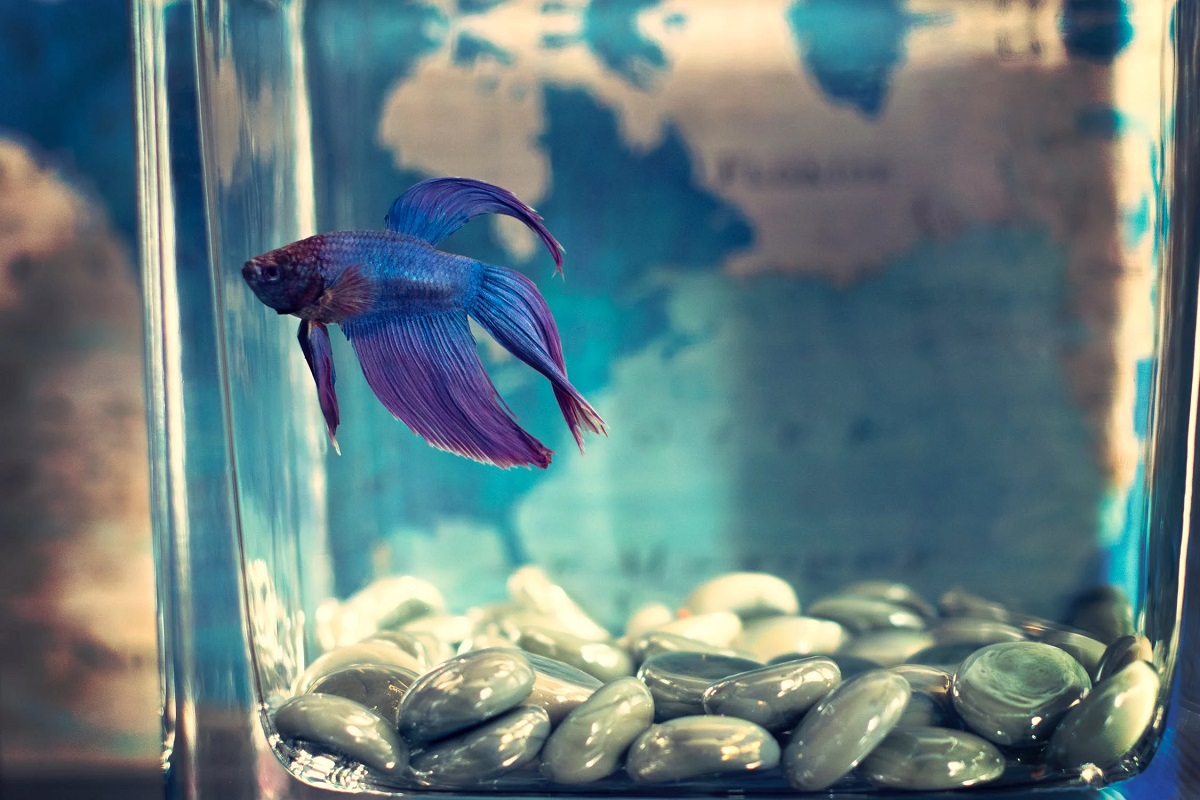Betta fish, also known as Siamese fighting fish, are popular pets worldwide.
The males have a reputation for their flowing fins and tails, and both sexes can come in various colors. One of the most uncommon yet beautiful colors is the elusive purple betta fish.
Like all betta fish, purple bettas have specific needs. They require spacious tanks and warm water, as well as carnivore-specific fish food. When you compare them to other breeds, the betta fish is fairly high-maintenance. However, their beautiful appearance makes them worth the effort.
Before you adopt a purple Siamese fighting fish, there are a few things you should keep in mind. Purple bettas are notably hard to find.
And if you’re looking for a pure purple betta fish, your search will be even tougher. These bettas can also be fairly expensive because they’re so difficult to breed.
So, are you wondering if the purple betta fish is right for you? After reading this guide, you may have a clearer answer to that question.
Contents
Can Betta Fish Be Purple?
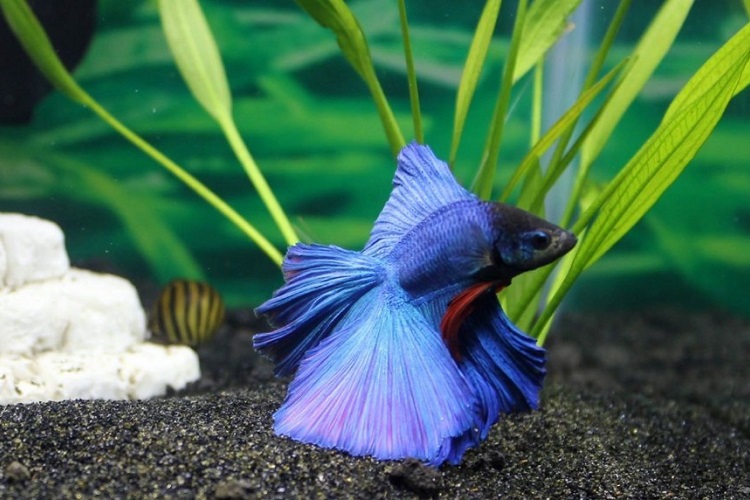
Do purple betta fish exist? The answer is yes—but they’re pretty rare, and true purple betta fish are even more so.
If you’re not an expert, distinguishing a true purple betta from a blue-purple betta can be pretty challenging. So, what is the difference? To tell them apart, you will need to take a closer look.
A blue-purple betta may look purple, but when you place it under different lighting, you will see that it’s blue. This coloring is somewhat rare, but overall, the blue-purple betta is not very difficult to find.
However, the true purple betta will remain purple regardless of the lighting. This coloring is incredibly rare. Breeding purple bettas is very challenging, too—even experienced breeders may never yield a perfect purple betta.
Their unique appearance and rarity have made the purple betta fish a hot commodity.
So if you’re lucky enough to find one for sale, prepare to pay a high price. Caring for these fish will also take a lot of effort, so they’re not an ideal choice for beginning fish owners.
Why Are Purple Bettas So Rare?
The main reason pure purple betta fish are so rare comes down to their genetics. They are not a naturally-occurring color of betta fish. Instead, they are a result of selective breeding.
The true purple betta gets its coloring from a rare genetic mutation. While breeding blue, pink, and red bettas can increase your chances of getting this mutation, getting a pure purple betta is simply a matter of luck.
There is essentially nothing you can do to increase your chances of breeding a pure purple betta.
And while blue-purple bettas are slightly more common than true purple ones, these fish are also quite rare for the same reason.
How Much Does a Purple Betta Fish Cost?
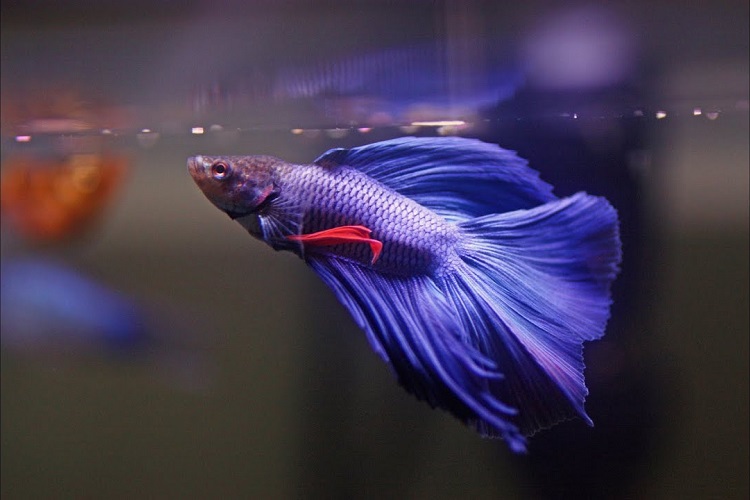
Because they are so rare, purple bettas can be a bit more expensive than your average betta. The price will also vary depending on whether you’re looking for a blue-purple betta or a true purple betta.
You can find the blue-purple betta for around twenty dollars from most sellers. They are a bit more expensive than your average betta fish, but an overall reasonable price.
As for the pure purple betta, these fish can be much more expensive. Because they’re so rare, finding information on where to buy them is difficult. But because they’re such a rare specimen, you can expect to pay at least several hundred dollars for a pure purple betta.
Breeding Purple Betta Fish
If you’re struggling to find a purple betta fish on the market, you may try to breed one of your own. However, you should bear in mind that breeding bettas is very challenging.
Many people have found purple bettas by breeding a royal blue male with a blue-and-red female. Others have bred purple bettas by mixing a pink male with a red female. However, neither of these combinations will guarantee a purple betta offspring.
If you feel like you’re up to the task, breeding purple bettas may be worth a try. Because betta fish are such a high-maintenance breed, this may not be an ideal project for a first-time fish breeder.
But if you have experience breeding fish and caring for bettas, breeding purple betta fish could be an exciting project!
What to Know Before Breeding Purple Betta Fish
Breeding fish takes a lot of time and resources. If you’re not willing to set aside plenty of time for caring for your fish, your selective breeding will not be successful.
Because bettas are a somewhat aggressive breed, you will need to monitor them closely. They’re very possessive over their territory, and if they feel another betta has invaded their space, things can get deadly rather quickly.
Males, in particular, are prone to fighting, so if you plan to breed several fish, each male will need to be in a tank separate from the other male bettas. On the other hand, female bettas can share a tank without problems.
Make sure the fish you’re breeding are healthy, too. Ensure that you’re adopting fish without any signs of illness, and keep them healthy once you’ve brought them home. They’re also more successful at breeding when they’re young—ideally, they should be under 14 months.
Bear in mind that betta fish can lay dozens of eggs at once. While many of these eggs may not hatch or reach adulthood, you should still be ready to take care of several fish once they have hatched. Bettas are by no means low-maintenance, so make sure you have the time and resources before you decide to breed them.
As long as you are careful and responsible, you have some pretty good chances of successfully breeding this beautiful fish. Of course, there is no guarantee of what you will yield, but providing your fish with the right environment and care will work in your favor!
How To Take Care of Purple Betta Fish
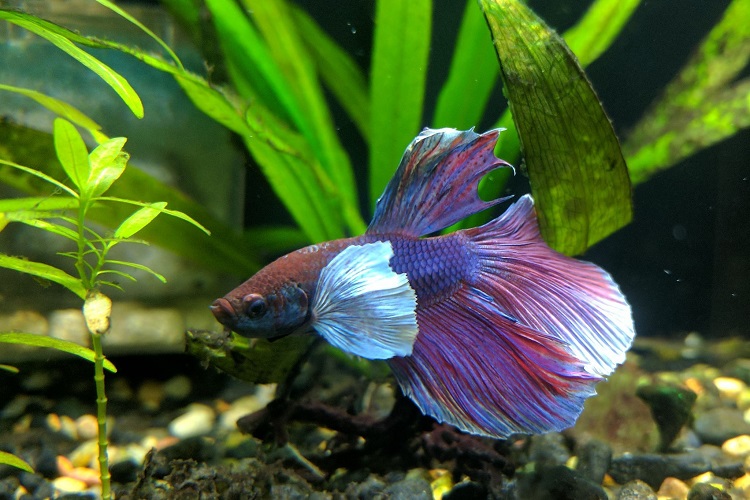
Once you get your hands on a purple betta fish, you will want to take very good care of it. These fish can be pretty expensive, so the last thing you want is to let them die.
But, more importantly, betta fish deserve a happy and comfortable life just like any other pet!
So if you want to give your purple bettas long and healthy lives, you will need to do a bit of preparation in advance. And once you bring these tropical fish home, be prepared to spend a fair bit of time caring for them.
Like all bettas, the purple betta fish is a rather high-maintenance breed. So if you are not ready to put in a lot of work for your new betta, you may want to consider a different kind of fish.
With that in mind, here is our thorough guide to properly caring for your purple betta fish! When you have the proper resources and care for your new pet, you can give them a happy and fulfilling life.
Purchase the Right Sized Betta Tank
When people think of betta fish, they often picture them living in small glass fish bowls.
In reality, these bowls are not the proper size for any fish, especially not a betta. So if you want to give your purple betta fish plenty of room to swim, you will need to purchase a pretty large tank.
One betta fish needs a minimum of three gallons of space in its tank. And if you’re planning on giving your purple betta tank mates, the tank should have an additional gallon for every fish.
The sizes of the other fish in your tank can make a difference, too. If you have any fish longer than an inch, add on another gallon of tank space for every inch.
Keeping your betta fish in a small tank can stunt their growth and make them ill. It can also potentially shorten their lifespan. Keeping your purple betta fish in a small tank can also promote aggressive behavior towards their tank mates, as these fish are a very territorial species.
Maintaining Proper Habitat Conditions

Betta fish originate from the warm freshwater lakes of southeast Asia.
Because of this, their tank will require a heater to stay at an appropriate temperature. The ideal temperature for your betta’s tank is between 75 and 80 degrees Fahrenheit.
If the water in your tank is too cold, your betta fish can get very ill. However, they can handle temperatures below 75 for short periods, so if you can’t get a heater right away, they should be fine as long as they are in a warm room. But in the long term, heating your purple betta’s fish tank is essential.
Temperature isn’t the only thing that matters in a betta fish’s habitat. The pH level of your tank’s water should be between 6.5 and 8.0. Maintaining the proper pH level can protect your purple betta fish from ammonia poisoning, so make sure to check your tank’s pH level from time to time.
In addition, you should clean your betta’s tank fairly often. Replace at least 15% of their water at least once per week, or 20% if you have a tank with several fish.
Changing their tank water is essential because fecal matter and bacteria can build up very quickly in your betta’s tank. Over time, this can make them seriously ill. However, you shouldn’t change all of the water at once because this can shock your betta fish. A partial water change is a better method.
When it comes to their filters, you should replace the cartridges at least once a month. You should also do a deep clean of the whole fish tank at least twice per year. This includes washing any decorations or equipment in the tank.
Feeding Your Purple Betta Fish
Betta fish feed on insects, small shrimp, and smaller fish in the wild. They may also occasionally graze on plant roots, but it is not a significant part of their diet.
Overall, these fish thrive on a carnivorous diet—so if you have any omnivorous fish such as goldfish or guppies, you may need to buy a different type of food for your bettas.
Betta-friendly fish foods come in five different categories: live, freeze-dried, frozen, pellets, and flakes. You can stick to one type of food if you prefer, or give them a combination of all five. No matter the type, what matters the most is giving your pet fish food that has the nutrients they need.
You can feed your betta fish once per day or twice if you divide their portion in half. The ideal daily amount of food for a betta fish is four pellets, or an equivalent amount if you’re using a different type of food.
Betta fish can survive a couple of days without eating, so don’t fret if you ever forget to feed them. That said, you should not make it a habit. If you frequently forget to feed your betta, consider getting an automatic fish feeder.
Choosing Tank Mates
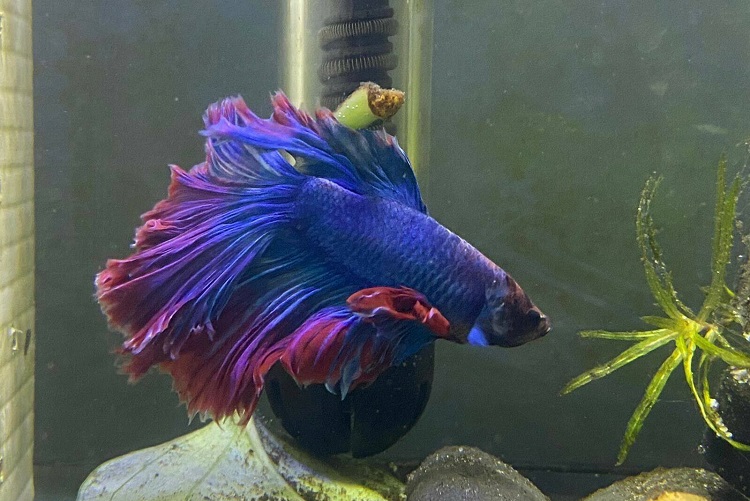
If you have enough space in your tank, you may want to get some tank mates for your purple betta fish. The purple betta is beautiful on its own, but when you pair it with some other fish in complementary colors such as yellow or green, your aquarium will truly pop.
As we mentioned before, male betta fish should be in separate aquariums. However, you can safely pair these fish with other species. And if you have female purple betta fish, you can easily pair them with other bettas as well.
A few possible tank mates for purple betta fish include:
- Snails
- Brine shrimp
- Guppies (avoid breeds with flowing tails, as male bettas can mistake them for their own)
- Clown pleco
- Kuhli loaches
- Corydoras catfish
Bear in mind that these animals may have different needs from your purple betta fish. So if you have several different animals living in one tank, you may need to buy several different kinds of food.
Choosing Tank Decorations
Tank decorations can help your aquarium look truly beautiful, especially if you are raising a purple betta fish without any other fish.
One of the best decorations for your purple betta’s tank is live plants. They can give your aquarium a more natural look and feel. They can even add more oxygen to your betta’s water! However, live plants will require more maintenance than fake ones, so prepare for a little extra work when you go with this option.
Java moss, marimo moss balls, anubias, and anacharis are just a few live plants that you can add to your purple betta’s tank.
Fake decorations can work just as well, but you should be very careful when choosing these. Avoid artificial plants with sharp plastic edges—these can cut your betta’s fins if they swim too close. Opt for softer plants when possible, particularly ones made from silk.
Betta fish enjoy some privacy from time to time, so adding some decorations where they can hide is another great idea.
Driftwood or hollowed stones are a suitable choice if you are going for a natural look. Alternatively, you can buy miniature houses, fake skulls, and vases if you prefer something more unique.
Adequate Oxygen Supply
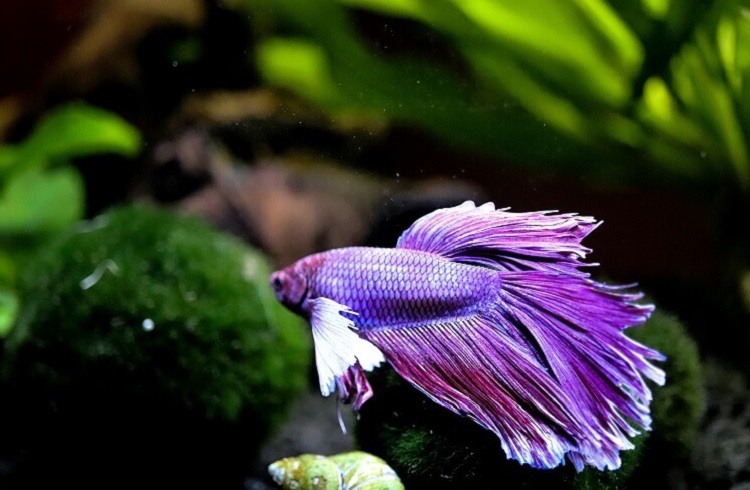
Bettas are unique from other fish because they receive oxygen from the water and air. This is why you will often see betta fish hanging near the surface of their tank. They use a special organ called the “labyrinth organ” to take in oxygen from the atmosphere.
This means you will not need an air pump in your betta’s tank unless you have other species that require it. However, you should allow ample space for your betta to swim to the surface and receive oxygen.
In addition, maintaining the oxygen supply in the water itself is important. Changing the water in their tank regularly and pouring water from a distance are a few ways you can improve the oxygen in your fish tank’s water.
Common Health Concerns and Prevention
When it comes to the health of purple betta fish, they share many commonalities with other betta varieties, yet there are unique aspects to consider. The most striking feature of a true purple betta, its vibrant color, can also be a health indicator.
- Fin Rot and Tail Biting: These are common in bettas, including the solid purple betta fish. Poor water conditions and stress are usual culprits. Regular tank cleaning and maintenance are crucial for prevention. If you notice ragged or discolored fins, it’s time to evaluate your fish’s living conditions and possibly seek treatment.
- Swim Bladder Disorder: This can affect your mermaid betta, often due to overfeeding or constipation. To prevent it, ensure a balanced diet and avoid overfeeding. Soaked frozen peas can sometimes help alleviate the symptoms.
- Bacterial and Fungal Infections: These can manifest in purple bettas, just like any other fish. To prevent these, maintain good water quality and quarantine any new additions to your tank. If you spot unusual spots, discoloration, or behavior, it might be time to consult a vet.
Remember, the key to a healthy purple betta fish lies in regular water testing, a clean tank, and a stress-free environment. Early detection and prevention are always better than cure.
Behavior and Temperament of Purple Bettas

The true purple betta, much like its counterparts, is known for its unique personality and behavior. Understanding these traits is essential for a harmonious tank environment.
- Territorial Nature: Bettas, in general, are territorial, and the solid purple betta fish is no exception. They often flare their gills to intimidate perceived threats. Providing ample space and hiding spots can help mitigate stress caused by territorial instincts.
- Interaction with Tank Mates: While the mermaid betta’s brilliant colors make them stand out, they can sometimes be aggressive towards other fish, especially those with similar fin structures or bright colors. Choosing the right tank mates is critical to avoid confrontations.
- Activity Levels: Purple betta fish are quite active and enjoy exploring their environment. Enriching their habitat with plants, caves, and other safe decorations can stimulate their natural behaviors and provide the mental stimulation they crave.
- Feeding Behavior: True purple bettas are carnivorous by nature and enjoy a varied diet of pellets, frozen, or live foods. They can become excited during feeding times, often leaping towards the surface for food.
Understanding and catering to the unique behaviors and temperaments of your purple betta fish will ensure they lead a happy, stress-free life in your aquarium. Observing their daily activities can also be a window into their health and well-being. Remember, a happy betta is often a healthy betta.
Summary
The purple betta fish is truly one of a kind. A distinct purple body is quite rare in bettas, and even more so if you’re going for a true purple betta fish. Because of this, it’s one of the most coveted betta fish colors around.
Their vibrant appearance can stand out in an aquarium of colorful fish. Because of their rarity, however, finding one can be quite a challenge. And if you’re hoping to breed a purple betta fish of your own, you are in for a tough task—successfully breeding one ultimately comes down to luck.
When it comes to caring for these beautiful fish, their needs are not any different from betta fish of other colors.
Finding the proper tank size, creating an accommodating habitat, and feeding them the correct type of food are essential. And when you pair them with suitable tank mates and choose betta-friendly decorations, you can expect your purple betta to thrive for years.

Ian Sterling, founder of Fishlab.com, began his aquarium journey over 30 years ago, driven by a deep fascination for fish and their diverse personalities. His website, Fishlab.com, is dedicated to making fishkeeping accessible and enjoyable, offering beginner-friendly guidance, expert insights, and a community for aquarists to connect and share experiences.


